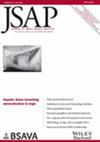Evaluating the impact of a standardised pre-operative patient management protocol on major post-operative complications in dogs undergoing BOAS surgery
Abstract
Objectives
Obstructive sleep apnoea syndrome is a common human upper respiratory tract disease that resembles Brachycephalic Obstructive Airway Syndrome in dogs, and pre-operative lifestyle changes are often recommended to minimise perioperative risk. To assess the effect of a standardised pre-operative protocol and early discharge on major post-operative complications in dogs undergoing Brachycephalic Obstructive Airway Syndrome surgery.
Materials and Methods
Medical records of Brachycephalic Obstructive Airway Syndrome surgery from February 2018 to May 2022 were evaluated. Exclusions comprised breeds other than the pug, French bulldog and English bulldog, patients undergoing concurrent procedures or those receiving partial pre-operative management, resulting in 45 pre-operative protocol cases and 45 controls. Post-operative regurgitation and major complications (defined as a requirement for >48 hours of hospitalisation, requirement for rehospitalisation within 48 hours, post-operative temporary/permanent tracheostomy or death) were recorded for each group.
Results
Median age and body condition were not different between groups. Pre-operative protocol patients had more severe respiratory and gastrointestinal clinical signs, were more likely to be affected by pre-operative regurgitation and had a higher grade of laryngeal collapse compared to controls. Median hospitalization time from surgery to discharge was shorter for the pre-operative protocol group (4.5 hours) compared to controls (29 hours). Major complications occurred in 5/45 (11.1%) pre-operative protocol cases and 4/45 (8.9%) control cases, with no significant difference. Post-operative regurgitation was noted in 14/45 (31.1%) pre-operative protocol cases and 19/45 (42.2%) control cases within 24 hours of surgery.
Clinical Significance
Although introducing a pre-operative protocol for patients undergoing Brachycephalic Obstructive Airway Syndrome corrective surgery cannot currently be recommended, no detriment was observed in patients being managed in this fashion.


 求助内容:
求助内容: 应助结果提醒方式:
应助结果提醒方式:


